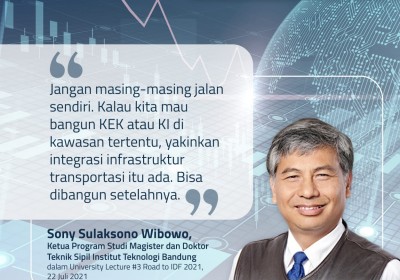The Importance of Integrating Transportation Infrastructure Into Industrial Zones
August 06, 2021
JAKARTA – In Indonesia, logistics tends to determine the price of products.
The Transportation Ministry (Kemenhub) notes that 40% of all logistical component fees come from the transportation sector, making the sector highly important to consider when developing a special economic zone (KEK) or industrial estates (KI). For one, the supply of raw materials depends on the state of transportation infrastructure in a certain region.
According to the Bandung Institute of Technology (ITB)'s head of civil engineering masters and doctoral programs Sony Sulaksono Wibowo, if these zones are not competitive enough then it will be hard to attract tenants to set up shop there.
"Especially if it functions in the tourism sector. That is a sector which greatly depends on transportation quality," he explained during the University Lecture #3 Road to Indonesia Development Forum 2021 webinar on Thursday (22/7).
Sony insisted that transportation services must function on a door-to-door basis. Currently, the government is treating the sea toll system under that method in a bid to shift more economic activity to the Eastern regions and lessen the price of goods in those regions.
"The sea toll system is run using a port-to-port system. But the problem lies afterward, on how to get goods from ports to retail. This is what needs to be paid attention to, as accessibility becomes a larger issue as time goes on," he explained.
The government has strengthened transportation access for some industrial zones, such as building roads which grant them direct toll road access. However, bridging the connectivity between toll roads and factories remains a challenge for the government.
"In Java, for example, access towards industrial zones, such as toll gates, and the condition of roads in their general areas, remain underdeveloped and sometimes neglected. KIs are attractive in the business sense, but the inadequate transportation infrastructure that serves them remains an obstacle," Sony said.
To address these infrastructural problems would need the cooperation of all stakeholders involved in the maintenance and management of KEKs and KIs, including the government, the operators and other relevant parties. Through partnerships between these parties, the industrial zones would help bring added value to the surrounding communities as well.
"If we were to make a KEK or a KI in a certain region, figuring out the transportation infrastructure must be one of the first priorities to be considered," Sony concluded.
Indonesia’s Research Institutions Supporting the Development of the Electric Vehicle Industry
Indonesian Muslim Fashion and Cosmetics IKMs Shine at Dubai World Expo 2020
Govt Steps Up UMKM Transformation Efforts in the Midst of Pandemic Slowdown
Govt Encourages Promotion of IKM Products in Digital Era
Government Begins Developing Maritime Training Center in Makassar
Tweets by IDDevForum
